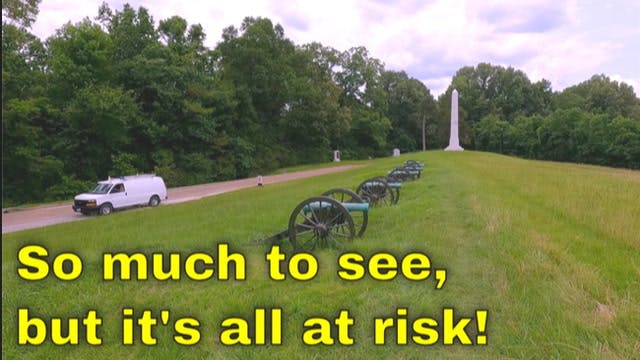Hawaii Volcanoes National Park and an Epic Hike up Mauna Loa Volcano
Join Alice as she explores Hawaii Volcanoes National Park and takes an epic hike up Mauna Loa Volcano.


Join Alice as she explores Hawaii Volcanoes National Park and takes an epic hike up Mauna Loa Volcano.
The pulse of what's trending on The Parks Channel. Check out the most watched videos.


32°21'0.42"N, 90°52'55.68"W
Vicksburg
Mississippi
Louisiana
Vicksburg NMP offers a great glimpse at a terrible time in our nation's history. Now it just needs to be kept up better!


18°20'43.19"N, 64°44'19.9"W
Virgin Islands National Park
U.S. Virgin Islands
Join Alice as she explores the US Virgin Islands National Park on St. John in the Caribbean. Start the day with a short hike and then hit the ocean.


22°12'43.65"N, 159°24'26.39"W
Hawai'i Volcanoes
Hawaii
Join Alice as she explores Hawaii Volcanoes National Park and takes an epic hike up Mauna Loa Volcano.

Bannack State Park, named for the indigenous Bannock people who inhabited the area, preserves the remnants of the once-thriving gold rush town of Bannack, which emerged in the 1860s. It was the site of Montana's first major gold discovery and became the capital of the newly established Montana Territory. Visitors can explore well-preserved buildings, including the sheriff's office, schoolhouse, and Masonic Lodge, offering a vivid glimpse into the Wild West's past. Grasshopper Creek meanders through the park, inviting anglers to try their luck in its pristine waters. With its rich history and scenic beauty, Bannack State Park provides a unique opportunity to connect with Montana's frontier heritage and the rugged charm of the Old West.
Go to park page
Homestead National Historical Park commemorates the passage of the Homestead Act of 1862, which allowed any qualified person to claim up to 160 acres of federally owned land. The Act eventually transferred 270,000,000 acres from public to private ownership. The park includes 100 acres of tallgrass prairie restored to approximate the ecosystem that once covered the central plains of the United States, and it is amazing to think that it was nearly plowed into extinction by the homesteaders. There are about 2.7 miles of hiking trails through the prairie and the woodland surrounding Cub Creek, accessible via all-terrain vehicle. The park also has an original cabin built in 1867 by George Palmer and a historic schoolhouse. The Homestead National Monument is great place to begin if you want to understand 19th century Americans life on the Great Plains.
Go to park page
The Thomas Stone National Historic Site is located in Charles County, Maryland and protects the home of Thomas Stone, one of the 56 signers of the United States Declaration of Independence. Known as Haberdeventure, the site provides an insight into 18th-century plantation life in Maryland. The house is a two-story, five-bay structure that was built in 1770. It is set on a stone foundation and has a gable roof. The interior of the house features 18th-century period furniture and appliances. The site also includes a kitchen garden, slave quarters, an orchard, and a number of outbuildings. Visitors to the site can take part in a number of ranger-led programs or self-guided tours. A visitor center located at the site has exhibits on the Declaration of Independence and the life of Thomas Stone.
Go to park page
Wrangell-St. Elias is the largest national park in the U.S. and rises from the ocean all the way up to 18,008 ft. At 13.2 million acres, the park is the same size as Yellowstone National Park, Yosemite National Park, and Switzerland combined! Known for its vast glaciers, towering peaks, and rugged landscapes, the park's diverse ecosystems are home to various indigenous cultures, including the Ahtna Athabascan people, who have inhabited this region for thousands of years. The park is also a haven for rare and unique wildlife and offers a glimpse into the untamed beauty of the Alaskan wilderness.
Go to park page
Go beyond Virgin Islands National Park's 7,000 acres of lush landscapes and pristine Caribbean coastline. Hike to historic plantation sites to learn about a challenging past when sugar and enslaved labor dominated life on the island. Visit the Indigenous Taino's ancient petroglyphs. Snorkel coral reefs to discover hidden marine life. Two-thirds of the island of St. John is national park, making it a unique destination for visitors.
Go to park page
Established in 1982 to designate 110,000 acres around the infamous volcano for research, recreation and education, the Mount St. Helens National Volcanic Monument is an unforgettable adventure. Seasonal activities include hiking, fishing, camping and snow sports. If you want to make the trek to the summit of the volcano, though, make sure to get a permit in advance.
Go to park page
We curate videos that entertain and inform. Join our growing community of creators – or simply explore.
Explore videos

Create your own profile, playlists and checklists.